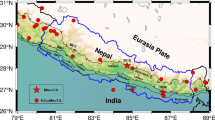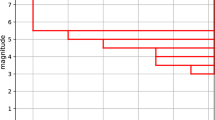Abstract
In earthquake fault systems, active faults release elastic strain energy in a near-repetitive manner. Earthquake forecasting that basically refers to the assessment of earthquake hazards via probability estimates is crucial for many strategic and engineering planning. As the current need across sciences dominantly grows for conceptualization, abstraction, and application, comparison of lifetime probability distributions or understanding their physical significance becomes a fundamental concern in statistical seismology. Using various characteristic measures derived from density function, hazard rate function, and mean residual life function with its asymptotic (limiting) behavior, the present study examines the similitude of the two most versatile inverse Gaussian and lognormal distributions in earthquake forecasting. We consider three homogeneous and complete seismic catalogs from northeast India, northwest Himalaya, and Kachchh (western India) region for illustration. We employ maximum likelihood and moment methods for parameter estimation, and Fisher information for uncertainty valuation. Using three performance tests based on Akaike information criterion, Kolmogorov-Smirnov criterion, and Anderson-Darling test, we show that the heavy-tailed lognormal distribution performs relatively better in terms of its model fit to the observed data. We envisage that the ubiquitous heavy-tailed property of lognormal distribution helps in capturing desired characteristics of seismicity dynamics, providing better insights to the long-term earthquake forecasting in a seismically active region.










Similar content being viewed by others
References
Angelier J, Baruah S (2009) Seismotectonics in Northeast India: a stress analysis of focal mechanism solutions of earthquakes and its kinematic implications. Geophys J Int 178(1):303–326
Bak P, Christensen K, Danon L, Scanlon T (2002) Unified scaling law for earthquakes. Phys Rev Lett 88(17):178501–1–178501–4
Bhatia A, Pasari S, Mehta A (2018) Earthquake forecasting using artificial neural networks. ISPRS-Int Arch Photogramm Remote Sens Spatial Inform Sci XLII-5:823–827
Bilham R (2004) Earthquakes in India and the Himalaya: tectonics geodesy and history. Ann Geophys 47(2/3):839–858
Chhikara RS, Folks JL (1977) The inverse Gaussian distribution as a lifetime model. Technometrics 19:461–468
Christos K, Eleftheria P, George T, Vassilios K (2018) Earthquake recurrence models and occurrence probabilities of strong earthquakes in the North Aegean Trough (Greece). J Seismol 22:1225–1246. https://doi.org/10.1007/s10950-018-9763-8
Cornell CA (1968) Engineering seismic risk analysis. Bull Seismol Soc Am 58:1583–1606
Davis PM, Jackson DD, Kagan YY (1989) The longer it has been since the last earthquake the longer the expected time till the next? Bull Seismol Soc Am 79:1439–1456
Ferraes SG (2003) The conditional probability of earthquake occurrence and the next large earthquake in Tokyo. J Seismol 7:145–153
Guess F, Proschan F (1985) Mean residual life: theory and applications. AFOSR Tech Rep 85:178
Gupta RC, Gupta RD (2007) Proportional reversed hazard rate model and its applications. J Stats Planning Inf 137:3525–3536
Gupta HK, Rao NP, Rastogi BK, Sarkar D (2001) The deadliest intraplate earthquake. Science 291:2101–2102
Hagiwara Y (1974) Probability of earthquake occurrence as obtained from a Weibull distribution analysis of crustal strain. Tectonophys 23:313–318
Hogg RV, Mckean JW, Craig AT (2005) Introduction to mathematical statistics. PRC Press, New Delhi
Jade S, Mukul M, Gaur VK, Kumar K, Shrungeshwar TS, Satyal GS, Dumka RK, Jagannathan S, Ananda MB, Kumar PD, Banerjee S (2014) Contemporary deformation in the Kashmir–Himachal, Garhwal and Kumaon Himalaya: significant insights from 1995–2008 GPS time series. J Geod 88:539–557
Johnson NL, Kotz S, Balakrishnan N (1995) Continuous univariate distributions. Wiley-Interscience, New York
Jordan TH (2006) Earthquake predictability, brick by brick. Seismol Res Lett 77(1):3–6
Kagan YY, Knopoff L (1987) Random stress and earthquake statistics: time dependence. Geophys J R Astron Soc 88:723–731
Kagan YY, Schoenberg F (2001) Estimation of the upper cutoff parameter for the tapered Pareto distribution. J Appl Probab 38:158–175
Kijko A, Sellevoll MA (1981) Triple exponential distribution, a modified model for the occurrence of large earthquakes. Bull Seismol Soc Am 71:2097–2101
Lee YT, Turcotte DL, Holliday JR, Sachs MK, Rundle JB, Chen CC, Tiampo KF (2011) Results of the regional earthquake likelihood models (RELM) test of earthquake forecasts in California. Proc Natl Acad Sci 108(40):16533–16538
Mahmoud M (1991) Bayesian estimation of the 3-parameter inverse Gaussian distribution. Trabajos De Estadistica 6(1):45–62
Matthews MV, Ellsworth WL, Reasenberg PA (2002) A Brownian model for recurrent earthquakes. Bull Seismol Soc Am 92(6):2233–2250
Mulargia F, Tinti S (1985) Seismic sample area defined from incomplete catalogs: an application to the Italian territory. Phys Earth Planetary Int 40(4):273–300
Nandy DR (2001) Geodynamics of north eastern India and the adjoining region. ACB Publications, Kolkata
Nishenko SP, Buland R (1987) A generic recurrence interval distribution for earthquake forecasting. Bull Seismol Soc Am 77:1382–1399
Parsons T (2008) Earthquake recurrence on the South Hayward fault is most consistent with a time dependent renewal process. Geophys Res Lett 35:L21301
Parvez IA, Ram A (1997) Probabilistic assessment of earthquake hazards in the north-east Indian peninsula and Hindukush regions. Pure Appl Geophys 149:731–746
Pasari S (2015) Understanding Himalayan tectonics from geodetic and stochastic modeling. PhD thesis, Indian Institute of Technology Kanpur, India
Pasari S (2017a) Reliability of an earthquake system: a case study from eastern Himalaya. Proceedings in International Conference on Disaster Risk Mitigation, Dhaka, Bangladesh (in press)
Pasari S (2017b) Design of earthquake catastrophe insurance scheme in northwest Himalaya: a preliminary study. Indian Cartographer 37:354–357
Pasari S (2018a) Nowcasting earthquakes in the Bay-of-Bengal region. Pure Appl Geophys (in press); doi: https://doi.org/10.1007/s00024-018-2037-0
Pasari S (2018b) Stochastic modelling of earthquake interoccurrence times in Northwest Himalaya and adjoining regions. Geomatics Nat Haz Risk 9(1):568–588
Pasari S, Dikshit O (2014a) Impact of three-parameter Weibull models in probabilistic assessment of earthquake hazards. Pure Appl Geophys 171(7):1251–1281
Pasari S, Dikshit O (2014b) Three-parameter generalized exponential distribution in earthquake recurrence interval estimation. Nat Hazards 73:639–656
Pasari S, Dikshit O (2015a) Distribution of earthquake interevent times in northeast India and adjoining regions. Pure Appl Geophys 172:2533–2544
Pasari S, Dikshit O (2015b) Earthquake interevent time distribution in Kachchh, northwestern India. Earth Planets Space 67:129
Pasari S, Dikshit O (2018) Stochastic earthquake interevent time modeling from exponentiated Weibull distributions. Nat Hazards 90(2):823–842
Pasari S, Mehta A (2018) Nowcasting earthquakes in the northwest Himalaya and surrounding regions. ISPRS-Int Arch Photogramm Remote Sensi Spatial Inform Sci XLII-5:855–859
Seshadri V (1999) The inverse Gaussian distribution, statistical theory and applications. Lecture Notes Statist, 137. Springer-Verlag, NY
Sharma Y, Pasari S, Dikshit O, Ching KE (2018) GPS-based monitoring of crustal deformation in Garhwal-Kumaun Himalaya. ISPRS-Int Arch Photogramm Remote Sens Spatial Inform Sci XLII-5:451–454
Sobolev GA (2011) Seismicity dynamics and earthquake predictability. Nat Hazards Earth Syst Sci 11:445–458
Sornette D, Knopoff L (1997) The paradox of the expected time until the next earthquake. Bull Seismol Soc Am 87:789–798
Stephens MA (1974) EDF statistics for goodness of fit and some comparisons. J Am Stat Assoc 69:730–737
Takagi K, Kumagai S, Matsunaga I, Kusaka Y (1997) Application of inverse Gaussian distribution to occupational exposure data. Ann Occup Hyg 1(5):505–514
Utsu T (1984) Estimation of parameters for recurrence models of earthquakes. Bull Earthq Res Inst Univ Tokyo 59:53–66
Wessel P, Smith WHF (1995) New version of the generic mapping tools released EOS trans. Am Geophys Union 76:329
Working Group on California Earthquake Probabilities. 2013. The Uniform California Earthquake Rupture Forecast Version 3 (UCERF 3), USGS Open File Report 2013–1165 and California Geological Survey Special Report 228 (http://pubs.usgs.gov/of/2013/1165/). Accessed 22 Feb 2019
Yadav RBS, Tripathi JN, Rastogi BK, Das MC, Chopra S (2008) Probabilistic assessment of earthquake hazard in Gujatat and adjoining region of India. Pure Appl Geophys 165:1813–1833
Yadav RBS, Tripathi JN, Rastogi BK, Das MC, Chopra S (2010) Probabilistic assessment of earthquake recurrence in northeast India and adjoining regions. Pure Appl Geophys 167:1331–1342
Yazdani A, Kowsari M (2011) Statistical prediction of the sequence of large earthquakes in Iran. IJE Trans B: Appl 24(4):325–336
Yin A (2006) Cenozoic tectonic evolution of the Himalayan orogen as constrained by along-strike variation of structural geometry, exhumation history, and foreland sedimentation. Earth Sci Rev 76:1–31
Acknowledgements
The author is thankful to the anonymous reviewer and the Editor in Chief for their constructive comments and suggestions. The Generic Mapping Tool (GMT) developed by Wessel and Smith (1995) is used in preparing some of the figures.
Funding
This research work is partially supported from a grant received from BITS Pilani under the scheme of Additional Competitive Research Grant (ACRG).
Author information
Authors and Affiliations
Corresponding author
Ethics declarations
Conflict of interest
The author declares that he has no conflict of interest.
Additional information
Publisher’s note
Springer Nature remains neutral with regard to jurisdictional claims in published maps and institutional affiliations.
Rights and permissions
About this article
Cite this article
Pasari, S. Inverse Gaussian versus lognormal distribution in earthquake forecasting: keys and clues. J Seismol 23, 537–559 (2019). https://doi.org/10.1007/s10950-019-09822-5
Received:
Accepted:
Published:
Issue Date:
DOI: https://doi.org/10.1007/s10950-019-09822-5




